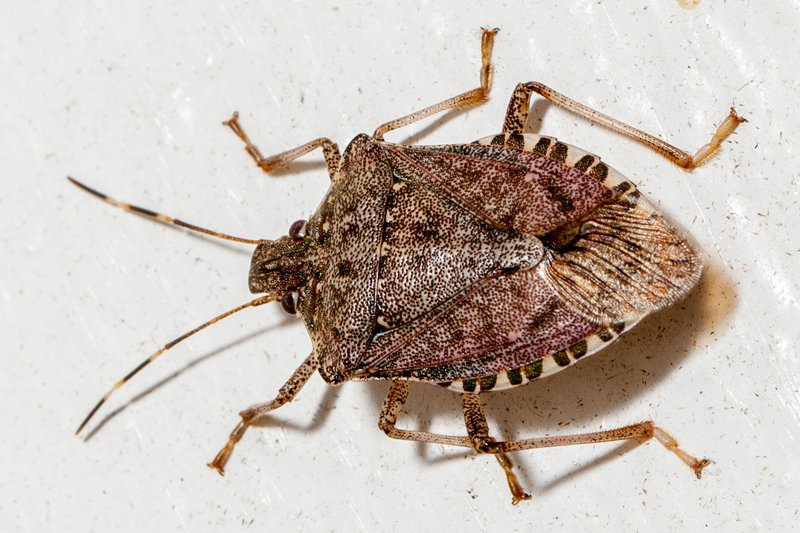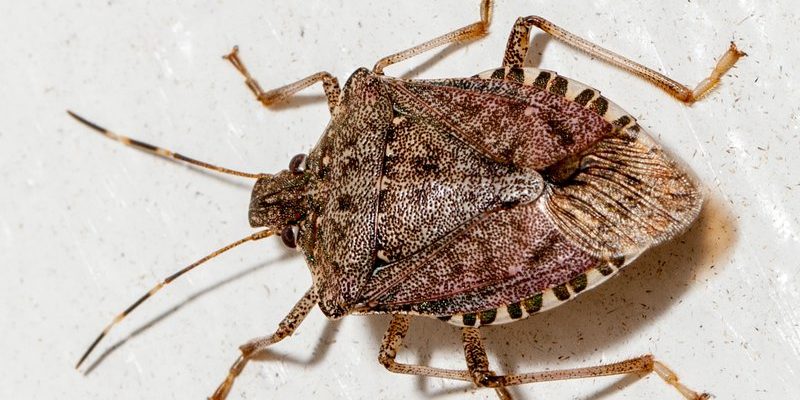
Have you ever been outside on a warm day, and suddenly found yourself wrinkling your nose at an uninvited guest? Meet the Brown Marmorated Stink Bug. This little critter isn’t just any bug; it’s one of the most notorious invaders in gardens, fields, and even homes across the United States. With its unmistakable shield-like shape and a knack for making its presence known, knowing about this pest can help you better understand how to coexist with—or combat—its presence.
Originally from Asia, this bug made its way to the U.S. in the late 1990s. Its uncanny ability to adjust to various environments has allowed it to thrive here, mainly because it’s a voracious eater. If you’re starting to worry about your plants and fruits, you’re not alone. The Brown Marmorated Stink Bug tends to munch on a variety of crops, making it a genuine concern for gardeners and farmers alike.
Physical Characteristics
Identification of the Brown Marmorated Stink Bug
Identifying the Brown Marmorated Stink Bug isn’t too complicated once you know what to look for. These bugs are typically about 1 inch long and have a distinct brown, mottled appearance that gives them their name. Their bodies are somewhat shield-shaped, tapering to a point at the back. Look closely, and you’ll notice white bands along their antennae and edges of their abdomen, which can help differentiate them from other similar-looking insects.
Another curious thing about these bugs is their behavior. When disturbed, they emit a potent odor. This is where they get their “stink” name! Some folks describe the smell as a mix between a rotten tomato and overripe fruit. You might not be keen to get up close and personal with one—trust me, the smell isn’t the most pleasant. But this defense mechanism keeps predators at bay, allowing them to survive and thrive.
Life Cycle of the Brown Marmorated Stink Bug
Understanding the life cycle of the Brown Marmorated Stink Bug is essential to managing their population. They undergo a process called incomplete metamorphosis, which means they start as eggs, transition into nymphs, and eventually mature into adults. The female lays her eggs in clusters on the undersides of leaves. These eggs are tiny, shiny, and can be yellow to greenish in color.
Once the eggs hatch, the nymphs appear, resembling miniature versions of the adults but without wings. These nymphs go through several stages, called instars, before reaching adulthood. Depending on environmental conditions, it typically takes about 30 to 60 days for them to become fully mature. Understanding this life cycle can help homeowners and farmers identify the best time to take action against them.
| Size | About 1 inch long |
| Color | Mottled brown with white bands on antennae |
| Habitat | Gardens, fields, and homes |
| Diet | Fruits, vegetables, and various plants |
| Life Span | Typically 6–8 months |
| Defensive Mechanism | Emits a strong odor when disturbed |
Feeding Habits
What Do They Eat?
The Brown Marmorated Stink Bug isn’t picky when it comes to food. It has a broad diet that includes a variety of fruits, vegetables, and ornamental plants. Some of its favorites include apples, peaches, tomatoes, and even soybeans. If you think about it, they have a buffet of options at their disposal, making them a common sight in gardens during growing seasons.
This pest uses its specialized mouthparts to pierce plant tissues and suck out the juices, which can lead to significant damage, including discoloration or distortion of the fruit or foliage. For gardeners, the experience can feel a bit like hosting a party where uninvited guests keep showing up for the free snacks! Sadly, their feeding can stunt plant growth and reduce fruit quality, making it crucial to keep them in check.
Impact on Agriculture
The impact of the Brown Marmorated Stink Bug on agriculture is extensive. Farmers find themselves battling these pests each year as they threaten crops and, ultimately, their livelihoods. The losses can be staggering; in some cases, entire fields can be compromised if an infestation occurs. Not only do these bugs feed on crops, but they can also spread plant diseases, adding another layer of concern.
One of the frustrating things is that they have few natural predators in the U.S. that can keep their populations in check. So, if you’re a farmer, prevention is key. Taking proactive measures to monitor populations and manage their feeding can save you not just time and effort but also financial losses.
Habitat and Distribution
Where Do They Live?
The Brown Marmorated Stink Bug is a versatile little creature. They adapt well to various habitats, including urban areas, rural farmlands, and wild spaces. Typically, they thrive in places where their food sources are abundant. You can find them basking in gardens, fields, and even your backyard — especially if you have fruit-bearing plants.
During colder months, they often seek refuge indoors. They love cozy spots and can easily slip into your home through tiny cracks and crevices. Once they’re in, they can be a nuisance, and you might notice them clustered in windows or corners. This behavior is particularly common in the fall as they look for a warm place to hibernate until spring.
Global Distribution
Originally from East Asia, the Brown Marmorated Stink Bug has successfully spread to many parts of the world. Since its accidental introduction to the U.S., it has expanded its range rapidly, now found in virtually every state. They’ve also made waves in parts of Europe, including Germany and Switzerland, where they have quickly established populations.
This global spread speaks volumes about their adaptability. They can survive in various climates and environments, which adds to their challenge as a pest. The key takeaway? Once they find a comfortable spot, they’re not likely to leave anytime soon.
Control Methods
How to Manage Stink Bug Populations
Feeling overwhelmed by the presence of the Brown Marmorated Stink Bug? You’re not alone! Luckily, there are effective ways to manage their populations and minimize damage to your plants. First, early detection is crucial. Regularly inspect your plants and keep an eye out for these bugs, especially during their peak activity in the warmer months. Catching them early can make a big difference.
Another practical step is to eliminate potential breeding grounds. Keep your garden tidy by removing debris, tall weeds, and any overripe fruit that may attract them. If they’re already in your home, simply vacuuming them up can be an effective method. Just remember to dispose of the bag immediately to avoid releasing those unpleasant odors back into your living space!
Natural Predators and Chemical Controls
While natural predators for the Brown Marmorated Stink Bug are limited in the U.S., introducing beneficial insects like ladybugs can help. On the other hand, if the infestation is severe, chemical controls may be necessary. Use pesticides that are specifically targeted for stink bugs and always follow the manufacturer’s instructions carefully. It’s essential to choose options that are safe for the environment and non-target species.
Ultimately, a combination of natural methods and, if needed, chemical controls can yield the best results. By staying vigilant and informed, you can work towards keeping the Brown Marmorated Stink Bug at bay.
The Brown Marmorated Stink Bug may seem like just another garden invader, but it packs a punch when it comes to its impact on agriculture and our everyday lives. Understanding its characteristics, life cycle, and control methods is crucial if you want to protect your plants and keep these critters from overstaying their welcome.
Remember, knowledge is power! By learning more about these pests, you’re on your way to taking action and finding a balance that allows you—and your plants—to thrive alongside them.
FAQ
What are the signs of a Brown Marmorated Stink Bug infestation?
If you suspect a Brown Marmorated Stink Bug infestation, look for signs such as visible bugs on your plants, feeding damage, or the smell when they’re disturbed. You may also notice clusters of their eggs on the undersides of leaves. It’s essential to act quickly to minimize damage to your plants.
Are Brown Marmorated Stink Bugs dangerous to humans?
No, Brown Marmorated Stink Bugs are not dangerous to humans. They do not bite or sting. However, their odor can be quite unpleasant, especially when they feel threatened. It’s best to handle them carefully or use a vacuum for removal.
Can you eat fruits that Brown Marmorated Stink Bugs have infested?
It’s generally not harmful to eat fruits that have had Brown Marmorated Stink Bugs on them, but it’s good practice to wash your produce thoroughly. However, if the fruit shows damage or discoloration from the bugs, it might be best to discard it for the best flavor and quality.
How can I prevent Brown Marmorated Stink Bugs from entering my home?
To prevent these bugs from entering your home, check for gaps in windows and doors, seal any cracks, and use screens on all openings. Keeping your yard clean and free of potential breeding grounds can also help reduce the likelihood of them making their way indoors.
What time of year are Brown Marmorated Stink Bugs most active?
Brown Marmorated Stink Bugs are most active during the warmer months, particularly in late summer and early fall. They tend to seek shelter indoors as temperatures drop, so you might notice them more during this time as they look for a cozy spot to hibernate.
Can Brown Marmorated Stink Bugs harm my garden plants?
Yes, they can cause significant harm to garden plants and crops by feeding on them. Their feeding may lead to stunted growth, loss of fruit quality, and even plant diseases. Therefore, keeping a close eye on your plants is crucial to prevent damage.
Are there organic methods to control Brown Marmorated Stink Bugs?
Absolutely! Organic methods such as using insecticidal soap, diatomaceous earth, or even introducing beneficial insects like wasps can help control their population. Regular monitoring and early intervention can make a big difference as well.
How do I differentiate Brown Marmorated Stink Bugs from other stink bugs?
Brown Marmorated Stink Bugs are identifiable by their distinctive shield shape, mottled brown surface, and white bands on their antennae and body edges. Comparing them to other stink bugs often reveals a lack of those unique markings, making identification easier.
Do Brown Marmorated Stink Bugs have any natural predators?
While their natural predators are limited in the U.S., they can be preyed upon by some birds and insects. However, many of these predators aren’t effective at controlling their populations due to the stink bug’s robust defenses. Thus, pest management strategies often rely on other methods.
What should I do if I find them in my home?
If you find Brown Marmorated Stink Bugs in your home, it’s best to vacuum them up carefully and dispose of the vacuum bag immediately. Avoid crushing them, as their odor can be quite strong. Sealing your windows and doors, and keeping your home clean can help deter them from returning.
Are there any specific times when they reproduce?
Brown Marmorated Stink Bugs typically reproduce during the warmer months, especially in late summer. After mating, females lay their eggs in clusters on host plants, which can lead to a rapid increase in population if not managed properly.

